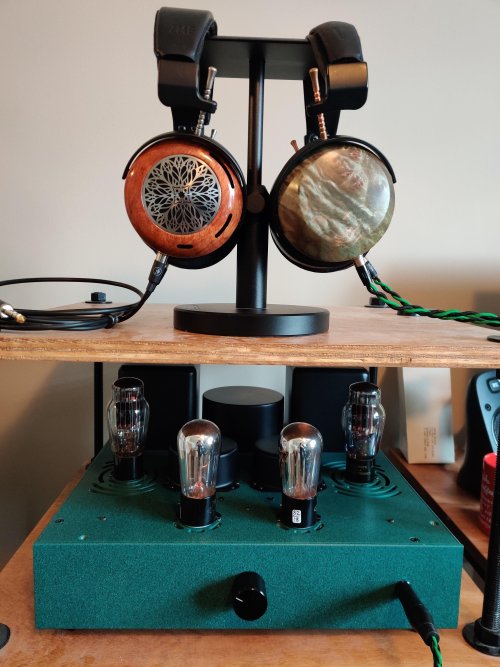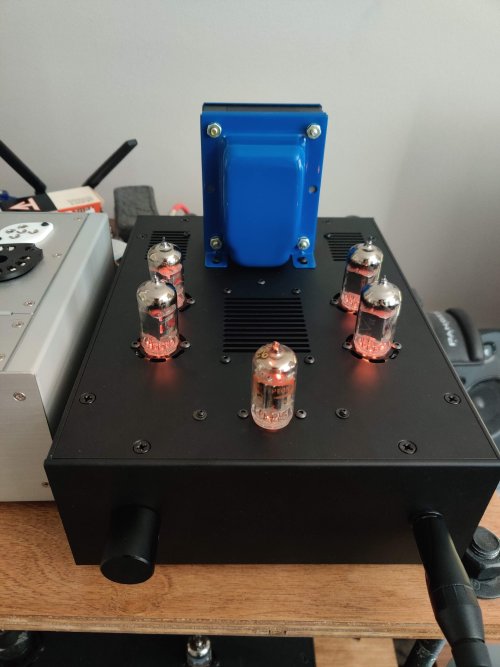Hey all, I have really leaned-in to the DIY scene over the last year, and I wanted to create this thread to share some of my DIY amplifier adventures. I have built cables, amplifier kits (bottlehead), restored vintage amps, but never built one from scratch like this. It was so much fun and I've learned so much doing this project.
This amp is based on the RH84 v2 circuit shown here: http://rh-amps.blogspot.com/2013/02/rh84-amplifier-revision-2_26.html . Much like the ZMF pendant, it runs on EL84 output tubes and a 12AT7/12AU7 input tube.
I have a tendency to crave doing things in a way that makes them unique... so I made the following changes to the design:
1. Modified the power supply to use two 6AX4 damper diodes instead of a more "standard" rectifier.
2. Added volume control.
3. Added a switch to switch between pentode and triode-strapped mode for the EL84s.
4. This is a headphone amplifier. I haven't seen this circuit built as a pure-headphone amplifier before.
Some specs:
- Outputs about 4W into 32 and 120 ohm headphones in pentode mode, or about 1.5W in triode mode.
- OPTs: custom by electraprint with 32 and 120 ohm secondaries.
- PT: Lundahl LL2741
- Headphone jacks are inspired by ampsandsound by having separate jacks for 32 and 120 ohms.
- PSU is CLCRC with a B+ of about 315V.
- Miflex coupling caps.
- 12AT7 driver can be swapped out for a 12AU7 for less gain and improved noise floor at the cost of some power.
- Chassis is from Landfall Systems
Overall I am so pleased with how this turned out! It sounds amazing and is extremely quiet. It is definitely on-par with my Mogwai SE. The inside is a little messy and some of the wire colors don't make sense because I ran out (like the rainbow of colors going to star-ground haha), but overall I'd say it's not bad.
Best combinations of outputs and headphones I've discovered so far:
- Pentode mode and 32 ohm jack with hard to drive planars (Hifiman Arya). My Arya sounds incredible with the high output power.
- Pentode or triode mode with 32 ohm jack for more sensitive high impedance dynamic headphones (ZMF).
- Triode mode with 120 ohm jack for high impedance dynamic headphones (ZMF)
Consider myself addicted to DIY. My next project will be more involved... I'm going to have to do a lot of design work instead of following a well-known circuit next time
Ok, Here's some pics!



This amp is based on the RH84 v2 circuit shown here: http://rh-amps.blogspot.com/2013/02/rh84-amplifier-revision-2_26.html . Much like the ZMF pendant, it runs on EL84 output tubes and a 12AT7/12AU7 input tube.
I have a tendency to crave doing things in a way that makes them unique... so I made the following changes to the design:
1. Modified the power supply to use two 6AX4 damper diodes instead of a more "standard" rectifier.
2. Added volume control.
3. Added a switch to switch between pentode and triode-strapped mode for the EL84s.
4. This is a headphone amplifier. I haven't seen this circuit built as a pure-headphone amplifier before.
Some specs:
- Outputs about 4W into 32 and 120 ohm headphones in pentode mode, or about 1.5W in triode mode.
- OPTs: custom by electraprint with 32 and 120 ohm secondaries.
- PT: Lundahl LL2741
- Headphone jacks are inspired by ampsandsound by having separate jacks for 32 and 120 ohms.
- PSU is CLCRC with a B+ of about 315V.
- Miflex coupling caps.
- 12AT7 driver can be swapped out for a 12AU7 for less gain and improved noise floor at the cost of some power.
- Chassis is from Landfall Systems
Overall I am so pleased with how this turned out! It sounds amazing and is extremely quiet. It is definitely on-par with my Mogwai SE. The inside is a little messy and some of the wire colors don't make sense because I ran out (like the rainbow of colors going to star-ground haha), but overall I'd say it's not bad.
Best combinations of outputs and headphones I've discovered so far:
- Pentode mode and 32 ohm jack with hard to drive planars (Hifiman Arya). My Arya sounds incredible with the high output power.
- Pentode or triode mode with 32 ohm jack for more sensitive high impedance dynamic headphones (ZMF).
- Triode mode with 120 ohm jack for high impedance dynamic headphones (ZMF)
Consider myself addicted to DIY. My next project will be more involved... I'm going to have to do a lot of design work instead of following a well-known circuit next time

Ok, Here's some pics!






































